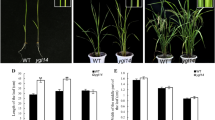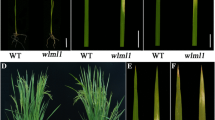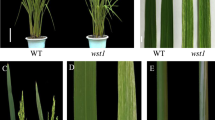Abstract
Leaf color turns yellow during senescence due to the degradation of chlorophylls and photosynthetic proteins. A stay green mutant was isolated from the glutinous japonica rice Hwacheong-wx through N-methyl-N-nitrosourea mutagenesis. Leaves of the mutant remained green, while turning yellow in those of the wild-type rice during senescence. The stay green phenotype was controlled by a single recessive nuclear gene, tentatively symbolized as sgr(t). All the phenotypic characteristics of the mutant were the same as those of the wild-type lines except for the stay green trait. The leaf chlorophyll concentration of the mutant was similar to that of the wild-type before heading, but decreased steeply in the wild-type during grain filling, while very slowly in the mutant. However, no difference in photosynthetic activity was observed between the stay green mutant and the yellowing wild-type leaves, indicating that senescence is proceeding normally in the mutant leaves and that the mutation affects the rate of chlorophyll degradation during the leaf senescence. Using phenotypic and molecular markers, we mapped the sgr(t) locus to the long arm of chromosome 9 between RFLP markers RG662 and C985 at 1.8- and 2.1-cM intervals, respectively.
Similar content being viewed by others
Author information
Authors and Affiliations
Additional information
Received: 29 April 2001 / Accepted: 17 July 2001
Rights and permissions
About this article
Cite this article
Cha, KW., Lee, YJ., Koh, HJ. et al. Isolation, characterization, and mapping of the stay green mutant in rice. Theor Appl Genet 104, 526–532 (2002). https://doi.org/10.1007/s001220100750
Issue Date:
DOI: https://doi.org/10.1007/s001220100750




